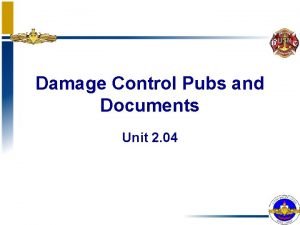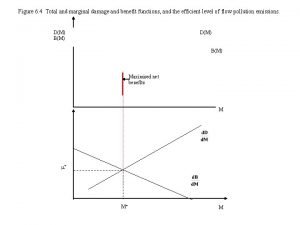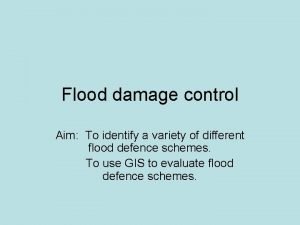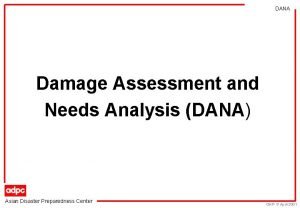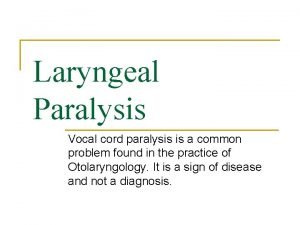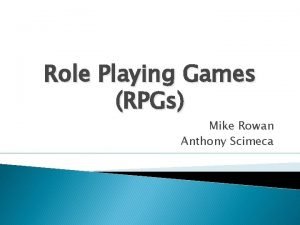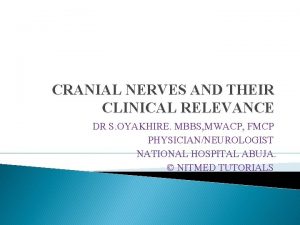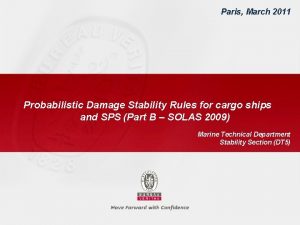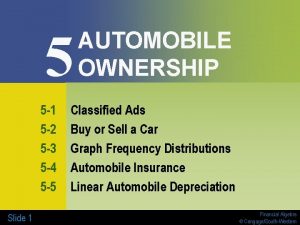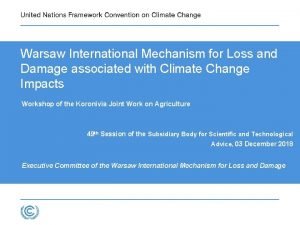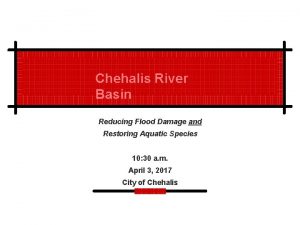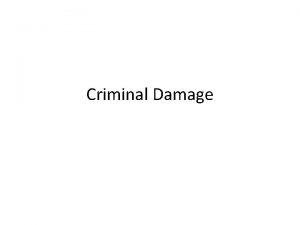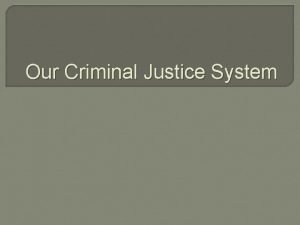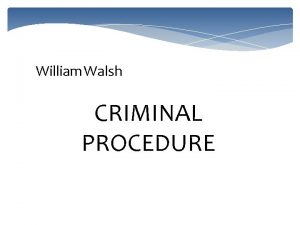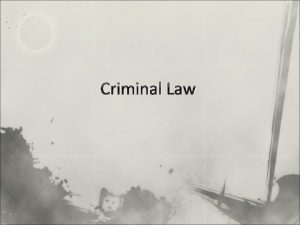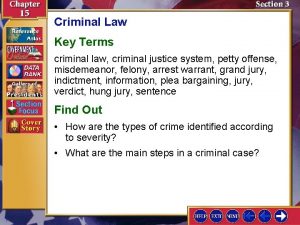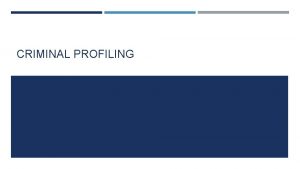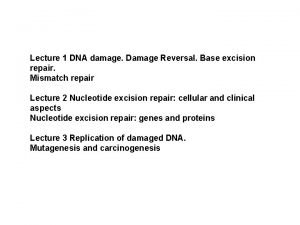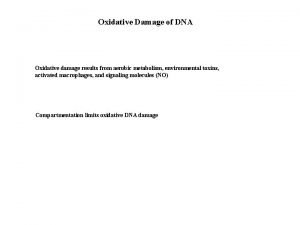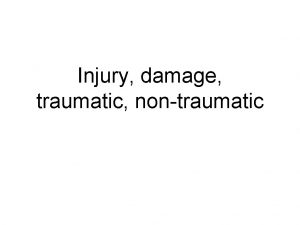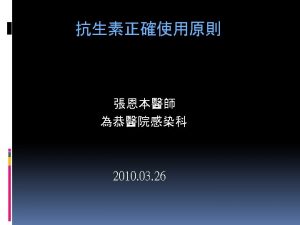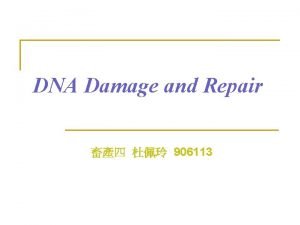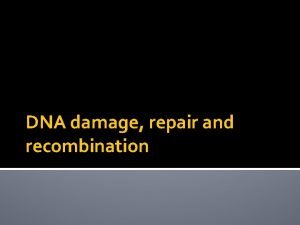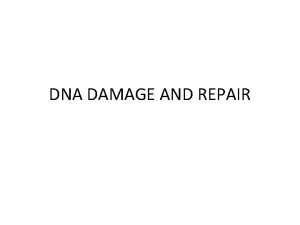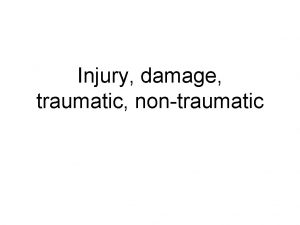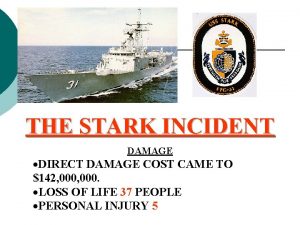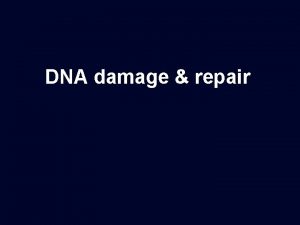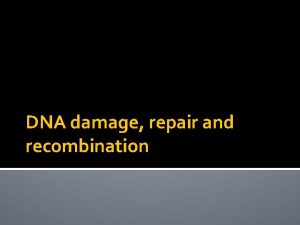Criminal Damage In this lecture we will Consider



























- Slides: 27

Criminal Damage In this lecture we will: • Consider the offences under the Criminal Damage Act 1971 • Explore the concept of recklessness • Consider the lawful excuses provided under the statute

Criminal Damage • The simple offence of criminal damage is contrary to s. 1(1) CDA 1971. • Definition – The intentional/reckless damage or destruction of property belonging to another without a lawful excuse. • Only one offence is created by the section - it is the same offence whethere is damage or destruction and whethere was intention or recklessness.

What constitutes damage? • Relevant caselaw: • A (a juvenile) v The Queen (1978) - the court adopted a definition of damage in terms of rendering imperfect or inoperative. • Roe v Kingerlee (1986) - damage is a question of fact and degree for the jury, applying their own common sense. • Hardman v Chief Constable of Avon and Somerset (1986) • Clear from these cases that the fact the harm is not permanent and is rectifiable does not prevent there being damage for the purposes of the statute. The amount of rectification required and the cost will be relevant.

What constitutes damage? • Another relevant consideration is whethere has been impairment of the value or usefulness of the property. See: • Cox v Riley (1986); • Whiteley (1991); • Morphitis v Salmon (1990).

What about removal of parts from a machine? • Fisher (1865) - removal of parts necessary for a machine to work constituted damage to the machine. • This would seem to be an application of the “rendering inoperative” test.

Does clamping a car constitute damage? • Drake v DPP (1994) - clamping a car did not constitute damage to the car as it did not involve any “intrusion into the integrity of the object”. • Prof Smith argues that clamping is damage as: • “if the car can be damaged by removing something, it seems logical that it can be damaged by adding something. The effect of attaching the clamp is no less drastic than removing the rotor arm. ”

PROPERTY BELONGING TO ANOTHER • Defined in s. 10 but if the subject matter is clearly property/clearly belongs to another, do not refer to s. 10. Only refer to the section where the issue is contentious.

MENS REA • Intention to do damage /destroy property belonging to another etc • Or • Recklessness as to damage etc

INTENTION • It must be proved by the prosecution that D not only intended the act which caused the damage but also to have intended that the act should cause damage to property belonging to another. • If D mistakenly believes he is damaging his own property, he will lack intent, see Smith (1974).

RECKLESSNESS • Recklessness involves foreseeing and taking an unjustifiable risk. • Who must have foreseen the risk - D or the reasonable man? • The leading case on recklessness is now R v G (2003) HL which overruled Caldwell (1981). • Recklessness is now subjective only.

The history of recklessness under the CDA 1971 • Following the coming into force of the CDA 1971, recklessness in criminal damage was held to be subjective only (often termed Cunningham recklessness) as illustrated by Stephenson (1979).

Caldwell Recklessness • A person was Caldwell reckless for the purposes of the CDA 1971 if: • He does an act (or fails to act when under a legal duty to act) which in fact creates an OBVIOUS risk that property will be destroyed or damaged AND when he does that act he EITHER: • (a) gives no thought to the possibility of there being any such risk OR • (b) recognises that there is some risk involved but nevertheless goes on to take it.

What was wrong with Caldwell recklessness? • Obvious risk and the identity of the reasonable man • Relevant caselaw: • Elliot v C (A minor) (1983); • R v R (1984); • Sangha (1988)

What was wrong with Caldwell recklessness? • The Caldwell lacuna or loophole • Relevant caselaw: • Chief Constable of Avon and Somerset Constabulary v Shimmen (1986); • Merrick (1996)

Why did the HL overrule Caldwell? • Parliament had intended that recklessness under the CDA 1971 be subjective. • Conviction of serious crime should require proof of a culpable state of mind. • The Caldwell direction was criticised by academics, judges and practitioners alike.

• Retaining Caldwell recklessness but in a modified form would have overcomplicated the task of the jury/magistrates: • “It is one thing to decide whether [D] can be believed when he says that the thought of a given risk never crossed his mind. It is another, and much more speculative, task to decide whether the risk would have been obvious to him if the thought had crossed his mind. ”

S. 1(2) CDA 1971 • Definition - the intentional/reckless damage or destruction of property without a lawful excuse and with the intention/recklessness as to endangering life thereby. • Differences between s 1(1) and s 1(2)? • (a) Under s 1(2) one may be liable for damaging one’s own property. • (b) Aggravating feature of intent / recklessness as to endangering life.

MUST LIFE BE ENDANGERED FOR LIABILITY UNDER S 1(2)? • No one’s life need be endangered. All that needs to be established is that D intended to endanger life or was reckless as to life being endangered (Parker (1993)).

“BY THE DAMAGE OR DESTRUCTION” • It is not sufficient that D merely intends to, or is reckless as to, endangering life by his act. D must intend to, or be reckless as to, endangering life by the damage he causes. • Relevant caselaw: • Steer (1987); • Webster & Warwick (1995)

ARSON - S 1(3) • Definition • How should D be charged? • Under section 1 (1) and (3) or under section 1 (2) and (3), as appropriate.

What type of fire damage will constitute arson? • The damage may be insignificant (it could just be charring of wood) but it is not arson if all that occurs is that property is merely blackened by smoke (would still be the simple offence of criminal damage, though. )

LAWFUL EXCUSE • S 5(2)(a) - belief that person(s) D believed entitled to consent to the damage has consented / would consent. • S 5(2)(b) - where damage was in order to protect (anyone’s) property which D believed was in immediate need of protection and D further believed that the means of protection adopted were reasonable in the circumstances. • These lawful excuses are only available to the simple, not the aggravated offence.

S. 5(2)(a) • Belief in the consent of someone with authority to give consent, even if given for the purposes of perpetrating a fraud will suffice (Denton (1982). • Belief in the consent of God is no defence (Blake v DPP (1993)).

S. 5(2)(b) • If D’s purpose is anything other than the protection of property, he cannot rely on this lawful excuse (Hunt (1977)).

• In Hill & Hall (1989), the court set out a 2 stage test: • (1) What was D’s actual state of mind when he damaged the property i. e. why did he do the damage? (the subjective question) AND • (2) Was the damage capable of protecting property in immediate need of protection? (the objective question - one of law for judge).

• The defence failed in Blake but was successful in Chamberlain v Lindon (1989).

• For the purposes of s. 5 it is immaterial whether the belief is justified or not if it is honestly held (s. 5(3)). • Thus, the belief under s. 5 need only be an honest belief. The lawful excuses are, therefore, available even where the belief is due to voluntary intoxication, see Jaggard v Dickinson (1980).
 01:640:244 lecture notes - lecture 15: plat, idah, farad
01:640:244 lecture notes - lecture 15: plat, idah, farad Storm damage berkeley
Storm damage berkeley Damage to the midbrain
Damage to the midbrain Problem has been detected and windows has been shut down
Problem has been detected and windows has been shut down Damage control equipment list
Damage control equipment list Texas 811 color codes
Texas 811 color codes Marginal damage function
Marginal damage function Barrie tornado damage
Barrie tornado damage Esd images
Esd images Emotional damage pictures
Emotional damage pictures 1 complete the table. which adjectives are negative
1 complete the table. which adjectives are negative Flood damage control
Flood damage control Car damage classification
Car damage classification Organ damage
Organ damage Dana asian
Dana asian Recurrent laryngeal nerve paralysis
Recurrent laryngeal nerve paralysis Trailer equipment damage reduction
Trailer equipment damage reduction Anthony scimeca
Anthony scimeca Imagine 3. hali
Imagine 3. hali Hypoglossal nerve damage
Hypoglossal nerve damage Vertical limit
Vertical limit Mold remediation somerset county
Mold remediation somerset county Why some earthquakes cause more damage than others
Why some earthquakes cause more damage than others 5-6 historical and exponential depreciation answers
5-6 historical and exponential depreciation answers Desco.com
Desco.com Ld damage
Ld damage 6056
6056 Flood damage restoration the basin
Flood damage restoration the basin




